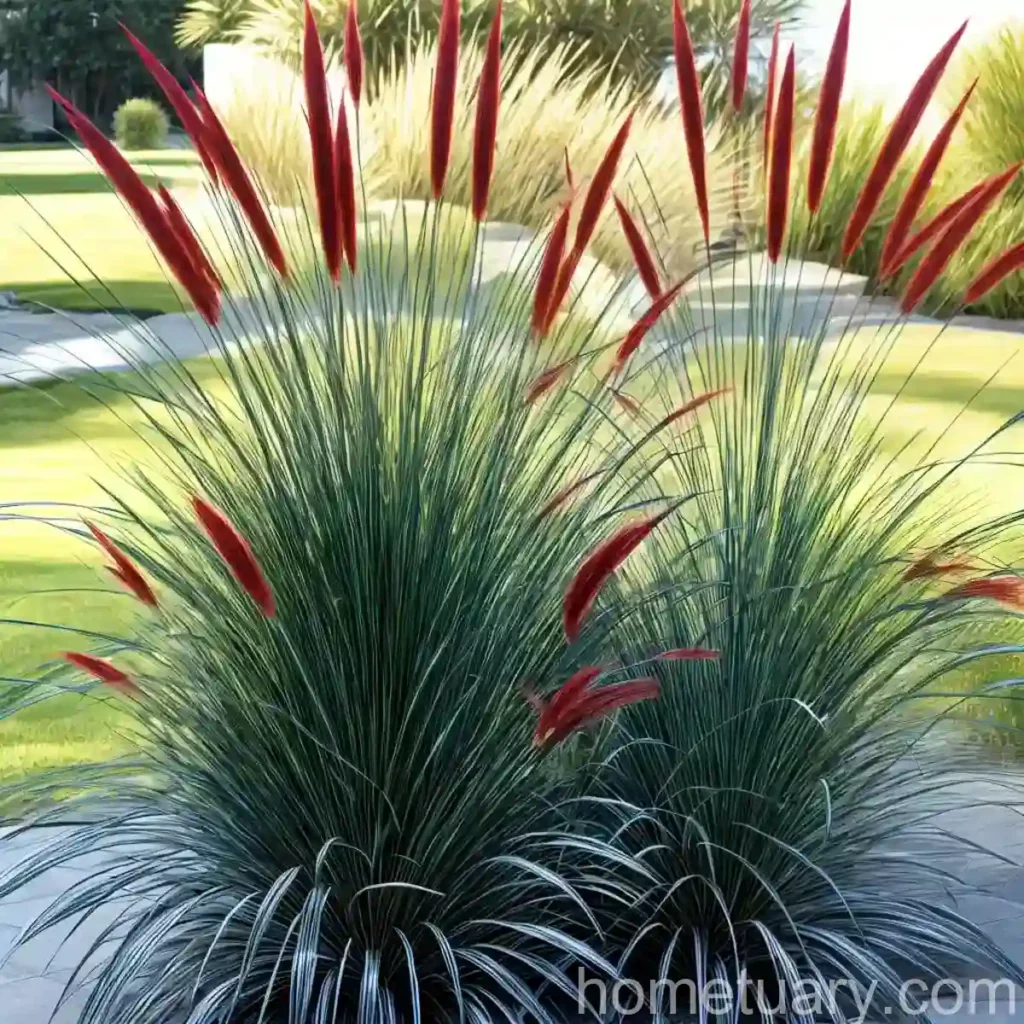Fountain Grass (Pennisetum setaceum ‘Fireworks’) – A Stunning Ornamental Grass for Your Garden
What is Fountain Grass?
Fountain grass (Pennisetum setaceum ‘Fireworks’) is a striking ornamental grass that belongs to the Poaceae family. It is renowned for its vibrant and attractive foliage, making it a popular choice for landscaping and gardens. The term ‘fountain grass’ derives from its graceful, arching growth habit, resembling the shape of a cascading fountain. This cultivar, ‘Fireworks,’ is distinguished by its vivid variegated leaves that display hues of burgundy, pink, and green, adding a dramatic flair to any garden or landscape. With its feathery plumes and low-maintenance nature, this plant is a favorite among gardeners and landscapers alike.
Key Takeaways – Fountain Grass (Pennisetum setaceum ‘Fireworks’)
To truly appreciate the beauty and potential of fountain grass (Pennisetum setaceum ‘Fireworks’) in your garden, it is crucial to understand its culture, uses, maintenance requirements, and the conditions that foster its optimal growth. This comprehensive guide will provide you with valuable insights into these aspects and various other aspects associated with this stunning ornamental plant.
Culture
Uses
Water
Sunlight
Fertilizer
Soil
Pruning
Propagation
Container
Popularity
Common Diseases
Disease diagnosis
Common pests
Botanist’s tips
Fun facts
Links to External Resources
Culture
Water
Fountain grass, particularly the ‘Fireworks’ cultivar, exhibits remarkable tolerance to drought conditions. Once established, it necessitates minimal watering, making it an exceptional choice for xeric or low-water landscapes. However, regular watering is essential during the initial establishment period, ensuring that the plant’s root system develops fully. It is advisable to water fountain grass sparingly to prevent waterlogged soil, which can lead to root rot and other moisture-related issues.
Sunlight
The ‘Fireworks’ fountain grass thrives in full sun, basking in at least six hours of direct sunlight each day. Adequate sunlight ensures the plant’s optimal growth and the development of its vibrant foliage. Insufficient sunlight may cause the plant to become leggy and diminish the intensity of its variegated colors. Therefore, it is crucial to position ‘Fireworks’ fountain grass in a location where it can receive ample sunlight to showcase its full splendor.
Fertilizer
This ornamental grass is undemanding when it comes to fertilization, but a balanced, slow-release fertilizer can be applied in spring to promote healthy growth and vibrant foliage. It is important to avoid excessive fertilization, as this can lead to an overgrowth of foliage at the expense of the plant’s overall health. A soil test can offer valuable insights into the specific nutrient requirements of your ‘Fireworks’ fountain grass, facilitating a targeted and effective fertilization regimen.
Soil
Fountain grass, including the ‘Fireworks’ cultivar, fares well in well-draining soils. It can adapt to a variety of soil types, ranging from loamy to sandy, as long as the soil is well-drained and does not retain excess moisture. Soil with poor drainage can lead to root rot and other detrimental conditions, emphasizing the significance of providing a suitable soil environment for the plant’s overall health and vigor.
Fountain grass (Pennisetum setaceum ‘Fireworks’) is a relatively low-maintenance plant, thriving in various conditions and proving to be a visually striking addition to landscapes and gardens. With its remarkable attributes and captivating aesthetics, it continues to capture the admiration of gardening enthusiasts and landscaping professionals alike. By mastering the essentials of its cultivation and care, you can fully appreciate the allure of this captivating ornamental grass in your outdoor spaces.
Uses
Popularity
Common Diseases
Disease Diagnosis
Common Pests
Botanist’s Tips
Fun Facts
Links to External Resources
Conclusion
In conclusion, fountain grass (Pennisetum setaceum ‘Fireworks’) stands as an exceptional ornamental grass variety, boasting a stunning display of variegated foliage and graceful, arching growth habits. With the comprehensive insights and guidelines provided in this blog post, you are equipped with valuable knowledge to cultivate and nurture this captivating plant in your garden or landscape. By embracing the low-maintenance nature and striking aesthetics of ‘Fireworks’ fountain grass, you can elevate the visual appeal of your outdoor spaces and revel in the natural beauty it offers throughout the seasons.
Keywords:
1. Fireworks fountain grass
2. Pennisetum setaceum ‘Fireworks’
3. Ornamental fountain grass
4. Fireworks pennisetum plant
5. Pennisetum setaceum cultivar
6. Red fountain grass
7. Purple fountain grass variety
8. Fireworks grass care tips
9. Growing Pennisetum setaceum
10. Beautiful ornamental grass
11. Fireworks fountain grass plant
12. Pennisetum setaceum ‘Fireworks’ varieties
13. Low-maintenance ornamental grass
14. Drought-tolerant fountain grass
15. Fireworks fountain grass landscape ideas
16. Perennial fountain grass
17. Fireworks pennisetum for gardens
18. Best companion plants for fireworks grass
19. Ornamental grass with burgundy foliage
20. Pennisetum setaceum ‘Fireworks’ characteristics
21. Showy grass for landscaping
22. Hardy grass for all climates
23. Fire-resistant fountain grass
24. Fountain grass for containers
25. How to propagate fireworks fountain grass
26. Fireworks grass in full sun
27. USDA hardiness zones for Pennisetum setaceum ‘Fireworks’
28. Native habitat of fireworks fountain grass
29. Fireworks grass as a border plant
30. Fireworks fountain grass in fall landscaping
31. Colorful grass for garden accents
32. Pennisetum setaceum ‘Fireworks’ in winter
33. Best soil for growing fireworks grass
34. Fireworks fountain grass in xeriscaping
35. Attractive grass for wildlife gardens
36. Landscaping with fireworks fountain grass
37. Fireworks pennisetum for containers
38. Fireworks grass for drought-resistant gardens
39. Fertilizer requirements for Pennisetum setaceum ‘Fireworks’
40. Unique foliage grass for mixed borders
41. Pennisetum setaceum ‘Fireworks’ size and height
42. Ornamental grass with burgundy plumes
43. Fireworks fountain grass as a focal point
44. Fireworks grass for erosion control
45. Maintenance tips for fireworks fountain grass
46. Fireworks pennisetum in commercial landscaping
47. Fireworks grass as a privacy screen
48. Fireworks fountain grass in rock gardens
49. Fireworks grass as a cut flower
50. Watering schedule for Pennisetum setaceum ‘Fireworks’















